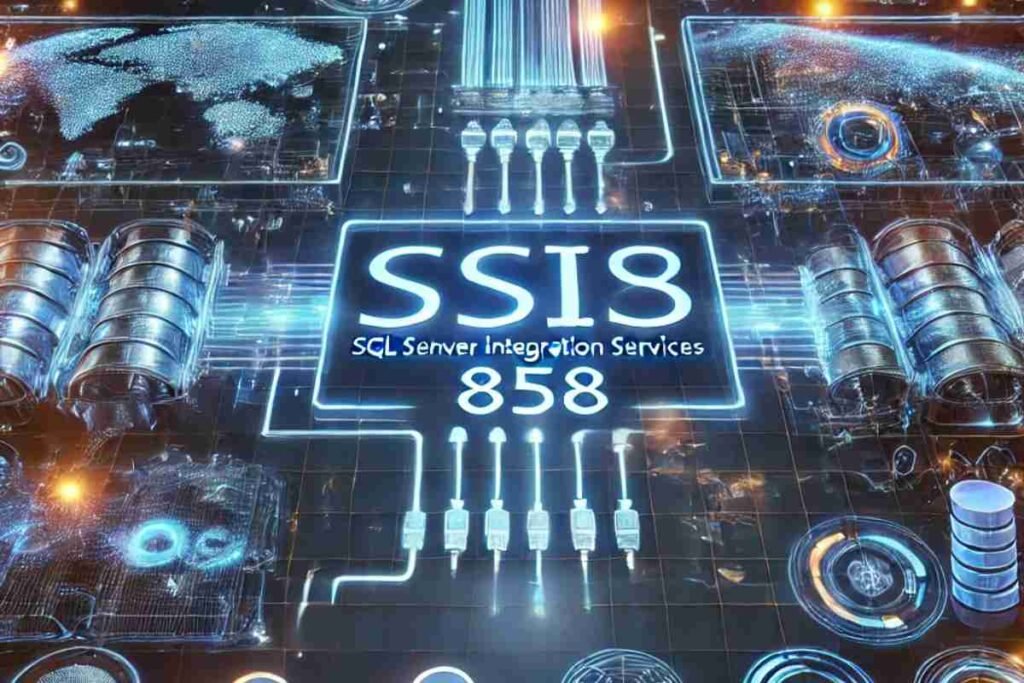Table of Contents
SQL Server Integration Services (SSIS) is a robust Extract, Transform, and Load (ETL) tool developed by Microsoft to handle data integration and workflow automation.
The evolution of SSIS has brought numerous enhancements, and SSIS 858 represents the latest advancements in performance, security, and scalability.
“This article explores the key features, benefits, and applications of SSIS 858, demonstrating how it can revolutionize data management for businesses, with expert insights from Technorozen.
What is SSIS 858?

SSIS 858 is the newest iteration of Microsoft’s SQL Server Integration Services, designed to address the increasing demands of data integration, transformation, and automation. It enhances efficiency, security, and flexibility, making it an essential tool for organizations dealing with vast amounts of data.
SSIS 858 is the newest and most advanced iteration of Microsoft’s SQL Server Integration Services (SSIS), designed to meet the growing and complex demands of modern data integration, transformation, and automation.
As businesses continue to generate and rely on vast amounts of data, the need for an efficient, secure, and flexible ETL (Extract, Transform, Load) solution becomes increasingly critical.
SSIS 858 builds upon its predecessors by offering enhanced capabilities, improved performance, and greater scalability, making it an indispensable tool for organizations striving to manage and process large-scale data efficiently.
One of the key improvements in SSIS 858 is its optimized performance for handling extensive datasets. The new version introduces better resource management, allowing for faster data extraction, transformation, and loading without compromising system performance.
This ensures that businesses can process and move large volumes of data seamlessly across different platforms while maintaining high efficiency.
The Importance of SSIS in Data Integration
SQL Server Integration Services (SSIS) is an essential tool for managing and integrating data from different sources. In today’s digital world, businesses collect massive amounts of data from various databases, applications, and external systems. SSIS helps combine all this information into a single, well-organized format, making it easier to use and analyze.
One of the biggest advantages of SSIS is its ability to automate the process of moving and transforming data. Instead of manually handling large datasets, businesses can use SSIS to efficiently extract data from different locations, clean and modify it as needed, and then load it into a central database or data warehouse.
Another important role of SSIS is improving data quality. Since data comes from multiple sources, it is often inconsistent, incomplete, or duplicated. SSIS includes features for cleaning, standardizing, and removing duplicate records, ensuring that businesses work with accurate and reliable data.
SSIS also helps organizations make better decisions by providing timely access to the right information. With well-integrated and high-quality data, businesses can analyze trends, identify opportunities, and optimize operations more effectively.
Key Features of SSIS 858
- Advanced Data Integration: SSIS 858 seamlessly connects with various data sources, including SQL Server, Oracle, cloud platforms, and NoSQL databases.
- Enhanced Performance & Scalability: Improved parallel processing and optimized memory utilization ensure faster data movement and handling of large datasets.
- Security Upgrades: SSIS 858 introduces advanced encryption techniques and improved access control mechanisms to safeguard sensitive information.
- Real-Time Data Processing: With better support for streaming and real-time data integration, businesses can make quicker decisions based on live data.
- Cloud Integration: Native support for Azure and other cloud services allows businesses to leverage cloud computing for efficient data processing.
- AI and Machine Learning Capabilities: The introduction of AI-powered data transformations enhances predictive analytics and data enrichment processes.
SSIS 858 and the ETL Process
The Extract, Transform, and Load (ETL) process remains at the core of SSIS 858. Let’s break it down:
Extraction
SSIS 858 extracts data from multiple structured and unstructured sources such as relational databases, Excel files, APIs, and cloud storage.
Transformation
Data is cleansed, formatted, and merged for consistency. SSIS 858 improves transformation efficiency by introducing AI-driven data quality checks and automated anomaly detection.
Loading
Transformed data is loaded into the target system, whether a data warehouse, a business intelligence tool, or a reporting system. The enhanced bulk-loading capabilities in SSIS 858 ensure faster data insertion with minimal downtime.
Use Cases and Applications of SSIS 858
SSIS 858 is used for data migration, real-time analytics, cloud integration, and automating complex ETL workflows.
Enterprise Data Warehousing
Businesses use SSIS 858 to integrate data from multiple departments into a centralized warehouse, making data analytics more effective and streamlined.
Business Intelligence & Reporting
With faster data transformation and improved real-time processing, SSIS 858 plays a crucial role in generating timely business reports and dashboards.
Data Migration & Cloud Adoption
Companies moving to cloud-based solutions benefit from SSIS 858’s enhanced cloud connectivity, allowing for seamless data migration to platforms like Azure and AWS.
Fraud Detection & Risk Analysis
AI-powered transformation features enable organizations to detect anomalies in financial transactions, improving fraud detection mechanisms.
IoT & Big Data Processing
With support for real-time streaming, SSIS 858 efficiently handles IoT data, making it an excellent tool for industries like manufacturing, healthcare, and smart cities.
Challenges and Considerations

Ensuring optimal performance, security, and compatibility with diverse data sources are key challenges to address.
Compatibility with Legacy Systems
Organizations must ensure compatibility with older SQL Server versions when upgrading to SSIS 858. Additional configurations and testing may be required.
Training & Skill Development
To maximize the potential of SSIS 858, companies must invest in training their IT teams in new features and best practices.
Migration Complexities
Moving from an older version of SSIS or another ETL tool can present challenges. Proper planning, testing, and execution strategies are necessary to ensure a smooth transition.
Conclusion
SQL Server Integration Services (SSIS) 858 marks a significant advancement in the field of data integration and ETL (Extract, Transform, Load) processes. As businesses continue to generate and rely on vast amounts of data, managing this data efficiently has become a top priority.
SSIS 858 addresses these needs by offering a comprehensive and powerful solution that enhances data workflows, improves performance, and strengthens security.
One of the standout features of SSIS 858 is its ability to handle complex data transformations with greater speed and efficiency. With AI-driven enhancements, the platform automates many tasks that previously required manual intervention, reducing errors and increasing overall productivity.
FAQs
How does the latest version enhance efficiency?
The new release includes optimizations that reduce processing time, improve resource utilization, and support larger datasets with greater speed and accuracy. It also minimizes bottlenecks, ensuring smoother data workflows.
What types of data sources can be connected?
It supports a wide range of formats, including structured and unstructured sources from databases, cloud platforms, APIs, and external data warehouses. Additional connectors allow integration with modern business intelligence tools.
Can this version be integrated with cloud-based services?
Yes, it offers expanded compatibility with multiple platforms, allowing seamless interaction with online storage solutions and applications. It also improves synchronization between on-premises and online environments.
Is it user-friendly for those without technical expertise?
Absolutely! The interface is designed with intuitive drag-and-drop functionality, making it accessible to both beginners and experienced users. Built-in templates and guided workflows further simplify the process.
How does it handle unexpected system failures?
Built-in recovery mechanisms and automated rerun features ensure minimal disruption and prevent data loss during interruptions. Smart error detection allows proactive issue resolution.
Does it support automation for routine tasks?
Yes, scheduling and workflow automation features help reduce manual effort and streamline data-related operations. AI-driven recommendations assist in optimizing automation settings.
What improvements have been made for large-scale operations?
It includes better load balancing, optimized memory usage, and parallel processing to handle extensive workloads more efficiently. These enhancements enable faster data movement across multiple environments.
What kind of support is available for troubleshooting?
Comprehensive logging, real-time monitoring, and detailed error-handling features assist in quickly identifying and resolving issues. A built-in diagnostic tool provides actionable insights for faster debugging.


